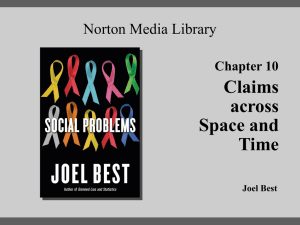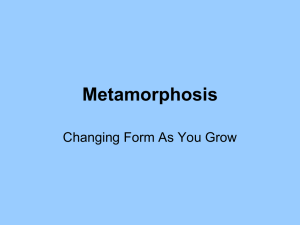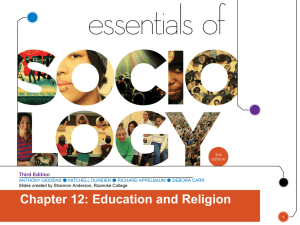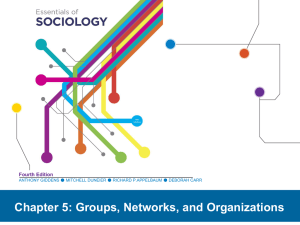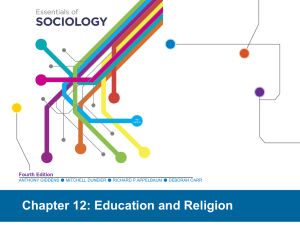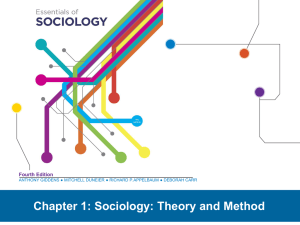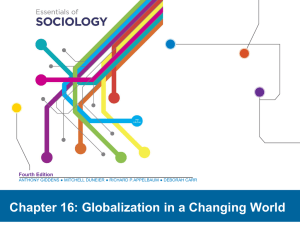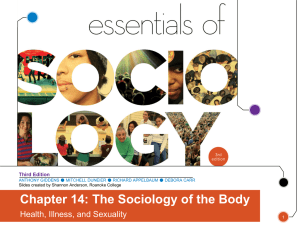Chapter 4
advertisement
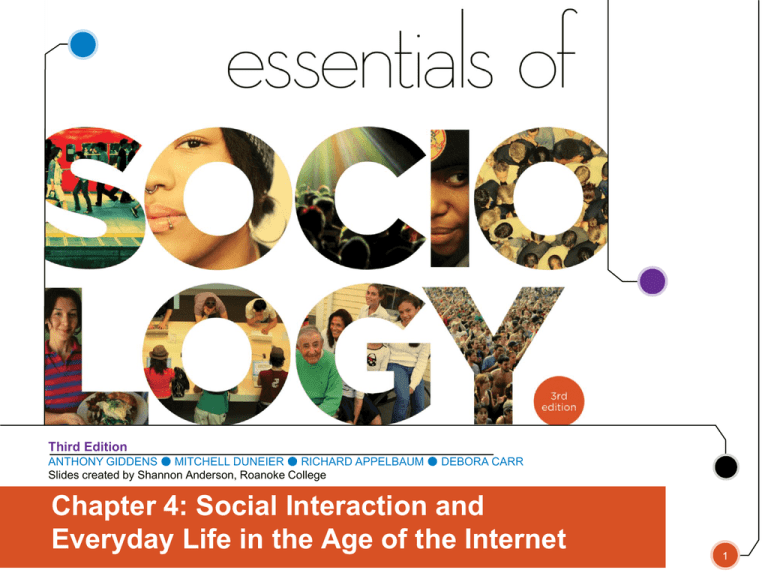
Third Edition ANTHONY GIDDENS ● MITCHELL DUNEIER ● RICHARD APPELBAUM ● DEBORA CARR Slides created by Shannon Anderson, Roanoke College Chapter 4: Social Interaction and Everyday Life in the Age of the Internet 1 Microsociology: Social interaction • Microsociology is an area that was first developed by Erving Goffman. • He took the belief that small aspects of social life matter, not just major institutions, and turned it into a systematic theoretical perspective and research methodology. • Goffman insisted that we look at all parts of human interaction and developed the dramaturgical perspective. © 2011 W. W. Norton Co., Inc. 2 Why microsociology matters • Goffman indicated at least three reasons why studying seemingly trivial aspects of social life matter: 1. Our everyday routines provide (and illustrate) the structure of our lives. 2. Interactions reveal the importance of human agency. 3. Interactions can tell us a lot about our larger society. © 2011 W. W. Norton Co., Inc. 3 Nonverbal communication • Nonverbal communication includes any exchange of information without speaking: – Face and gesture – Email and other online communication – Use of “props” and setting – Personal space – Presentation of self © 2011 W. W. Norton Co., Inc. 4 Impression management • To explicate his perspective on social interaction, Goffman wrote The Presentation of Self in Everyday Life. • He outlined the way in which social life was, in its essence, theater: – We play roles for audiences. – We inhabit stages and sets. – We make use of props and scripts. © 2011 W. W. Norton Co., Inc. 5 Impression management • An important part of all interactions is to attempt to actively control the way others perceive you. • This is the heart of impression management, and it is crucial to identity construction. • Different roles we play require different impression management; some impression management is sincere and some is cynical. © 2011 W. W. Norton Co., Inc. 6 Impression management: Costume • Every day each of us starts by getting dressed, which is a crucial piece of impression management. • With what we wear, we reveal a great deal of social information alluding to class, subculture, sexuality, interests, and sometimes even politics or ideas. © 2011 W. W. Norton Co., Inc. 7 Types of interaction • There are two basic types of interaction: focused and unfocused. • Focused interactions, or encounters, are those where we directly engage someone. • Unfocused interactions are those where we are present with others, but do not communicate directly with them. © 2011 W. W. Norton Co., Inc. 8 Audience segregation • Because we all play different roles and these different roles require different forms of impression management, we often attempt to keep our audiences segregated. • In certain types of online communication (e.g., Facebook), this is more difficult, yet it is critically important. © 2011 W. W. Norton Co., Inc. 9 Stacy Snyder was an aspiring teacher who was about to graduate from Millersville University’s School of Education in 2006. Essentials Of Sociology, 3rd Edition Copyright © 2011 W.W. Norton & Company What does it mean? • Part of examining social interaction is to try to determine meaning even when it is unspoken. • Read these lines: What do they mean? A: I have a fourteen year-old son. B: Well, that’s all right. A: I also have a dog. B: Oh, I’m sorry. © 2011 W. W. Norton Co., Inc. 11 Context matters • We learn to make sense of what people, say not only through words, but also through what your textbook calls shared understandings. • Communication, then, is based, not only on what we say, gesture, and do, but also on a set of shared cultural understandings. © 2011 W. W. Norton Co., Inc. 12 Ethnomethodology • Harold Garfinkel introduced the study of how we make sense of interactions and called this approach ethnomethodology. • Ethno means folk, or lay, so ethnomethodology means understanding how everyday people make sense of interactions. © 2011 W. W. Norton Co., Inc. 13 Ethnomethodology in practice • Garfinkel had his students test the idea of background expectancies by having his students challenge them. • Example of challenges: – Answering the question “How are you?” with a complete response or a query for specification. © 2011 W. W. Norton Co., Inc. 14 Studying talk • It is also important to look at the actual talk taking place in interactions. • How we converse—how we actually use words—is foundational to constructing and maintaining a stable, comprehensible social world. © 2011 W. W. Norton Co., Inc. 15 Conversation analysis • Conversation analysis is a research method wherein all aspects of interaction are noted and assessed for meaning. • The words themselves, timing, order, and even status of participants are all examined. © 2011 W. W. Norton Co., Inc. 16 Micro-macro linkage • Oftentimes looking at micro-level interactions can reveal patterns in the society at large. • Ethnographic studies have, for example, illuminated racial and gender inequalities, fear of the homeless, and power structures in corporations. © 2011 W. W. Norton Co., Inc. 17 Why microsociology matters • Studying social interaction is important because it allows us to learn at the level of the everyday and then make connections upward. • Good microsociology also tells us something about how a society is structured and restructured in everyday interactions. • Microsociology offers “thick description.” © 2011 W. W. Norton Co., Inc. 18 Time and space • Social life is divided temporally. – For example, our days, weeks, and even months are organized in such a way that we know what to expect on a July day versus a December day. • Social life is divided spatially. – For example, our lives are also organized so that we know that at college there are certain expectations that are different in the classroom than the dorm room. © 2011 W. W. Norton Co., Inc. 19 This concludes the Lecture PowerPoint Presentation for Chapter 4: Social Interaction and Everyday Life in the Age of the Internet For more learning resources, please visit our online Study Space at: http://www.wwnorton.com/college/soc/essentials-of-sociology4/ W. W. Norton & Company Independent and Employee-Owned © 2011 W. W. Norton Co., Inc. 20 Clicker Questions 1. Marcie and Pat were out to dinner on a blind date. After dessert, Marcie made eye contact with and waved over the server, raising her hand out to the side of the table in order to indicate that she would be taking care of the bill. Marcie’s cues to the server are all examples of a. ethnomethodology. b. regionalization. c. nonverbal communication. d. response cries. © 2011 W. W. Norton Co., Inc. 21 Clicker Questions 2. Ethnomethodology studies which of the following? a. conversations in a café b. voting patterns in presidential elections c. rates of drug use among college students d. cross-national infant mortality rates © 2011 W. W. Norton Co., Inc. 22 Clicker Questions 3. Examining all facets of a conversation for meaning—from the smallest filler words (such as umm and ah) to the precise timing of interchanges (including pauses, interruptions, and overlaps) is called a. interactional vandalism. b. focused interaction. c. compulsion of proximity. d. conversation analysis. © 2011 W. W. Norton Co., Inc. 23 Clicker Questions 4. Roles are a. socially defined. b. studied in terms of time and geography. c. where people act in front regions. d. nonverbal communication. © 2011 W. W. Norton Co., Inc. 24 Clicker Questions 5. What is focused interaction? a. Individuals directly attend to what others say and do. b. the examination of all facets of a conversation for meaning c. Individuals act out formal roles in the social occasions or encounters. d. a form of mental interaction that includes facial expression, gestures, and body movements. © 2011 W. W. Norton Co., Inc. 25 Clicker Questions 6. In a society such as our own, many of the people with whom we come in contact over the course of a given day are strangers. What is the technique we use to communicate to a stranger that we are not suspicious of or hostile to him or her and that we do not wish to avoid them? a. a hard stare b. a quick glance and then a look away c. a complete avoidance of the other person’s eyes d. a big smile and a quick “how-do-you-do” © 2011 W. W. Norton Co., Inc. 26 Art Presentation Slides Chapter 4 Social Interaction and Everyday Life in the Age of the Internet Anthony Giddens Mitchell Duneier Richard P. Appelbaum Deborah Carr Chapter Opener Essentials Of Sociology, 3rd Edition Copyright © 2011 W.W. Norton & Company Walking along a crowded city street, one engages in civil inattention. Essentials Of Sociology, 3rd Edition Copyright © 2011 W.W. Norton & Company (a) (b) (c) (d) (a) Your friend had come and you were happy (b) Your child had died (c) You were angry and about to fight (d) You saw a dead pig that had been lying there a long time. Essentials Of Sociology, 3rd Edition Copyright © 2011 W.W. Norton & Company Identify examples of focused and unfocused interaction in this photograph by Jeff Wall. Essentials Of Sociology, 3rd Edition Copyright © 2011 W.W. Norton & Company Stacy Snyder was an aspiring teacher who was about to graduate from Millersville University’s School of Education in 2006. Essentials Of Sociology, 3rd Edition Copyright © 2011 W.W. Norton & Company How do background expectancies influence our conversations? Essentials Of Sociology, 3rd Edition Copyright © 2011 W.W. Norton & Company Globalization and Everyday Life Essentials Of Sociology, 3rd Edition Copyright © 2011 W.W. Norton & Company Cultural norms frequently dictate the acceptable boundaries of personal space Essentials Of Sociology, 3rd Edition Copyright © 2011 W.W. Norton & Company How has electronic communication Transformed social interaction? Essentials Of Sociology, 3rd Edition Copyright © 2011 W.W. Norton & Company W.W. Norton & Company Independent and Employee-Owned This concludes the Art Presentation Slides Slide Set for Chapter 4 Essentials Of Sociology THIRD EDITION by Anthony Giddens Mitchell Duneier Richard P. Appelbaum Deborah Carr
